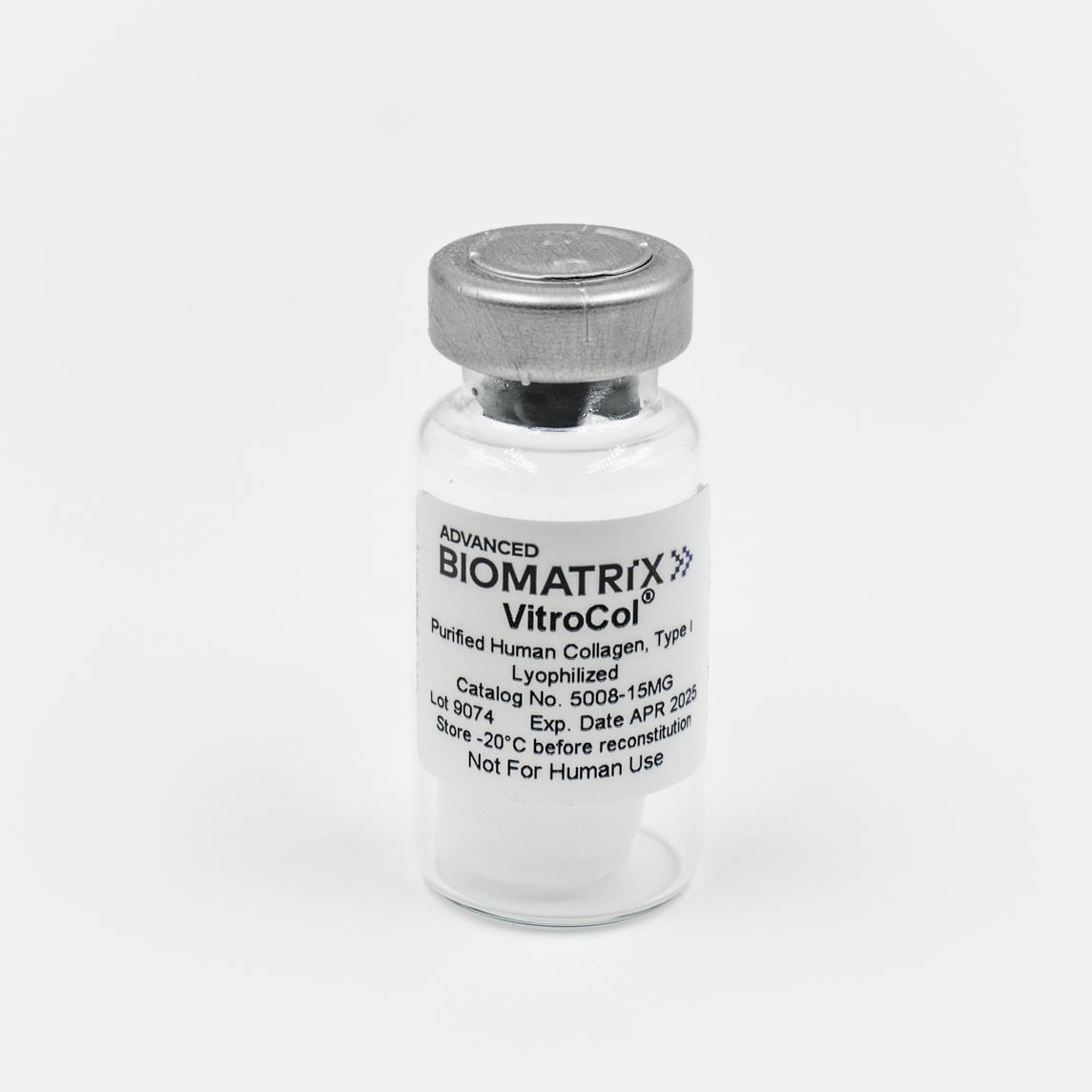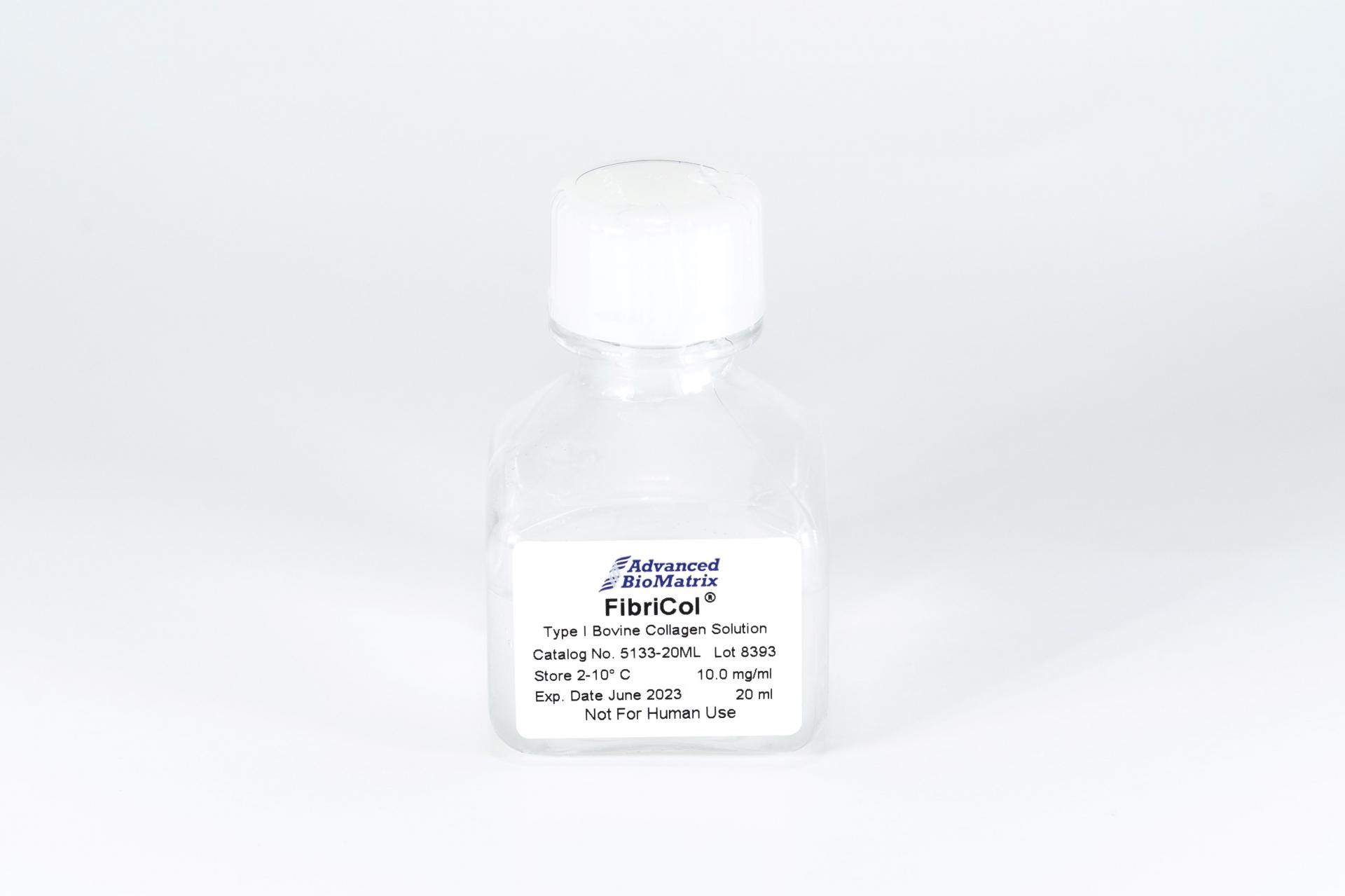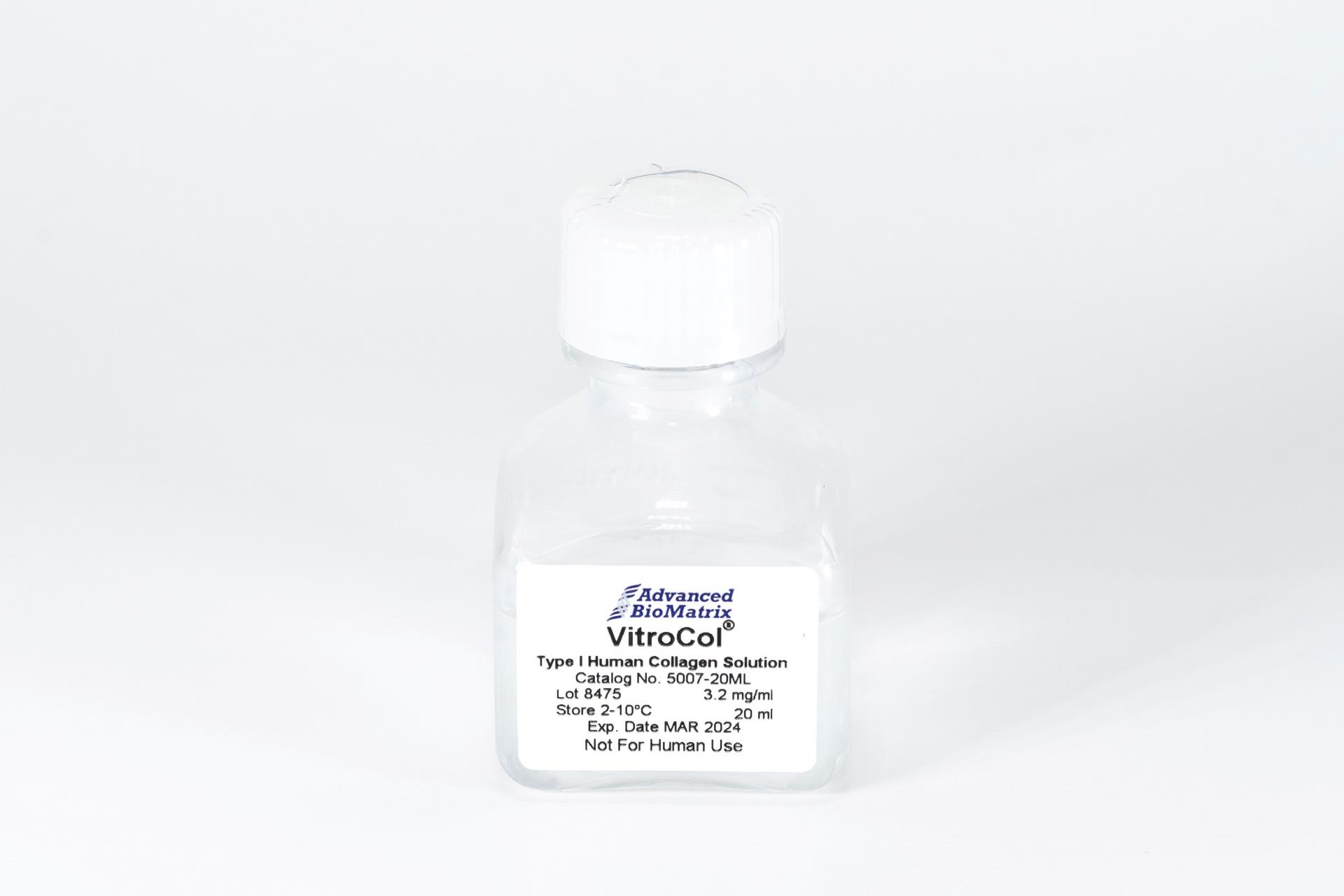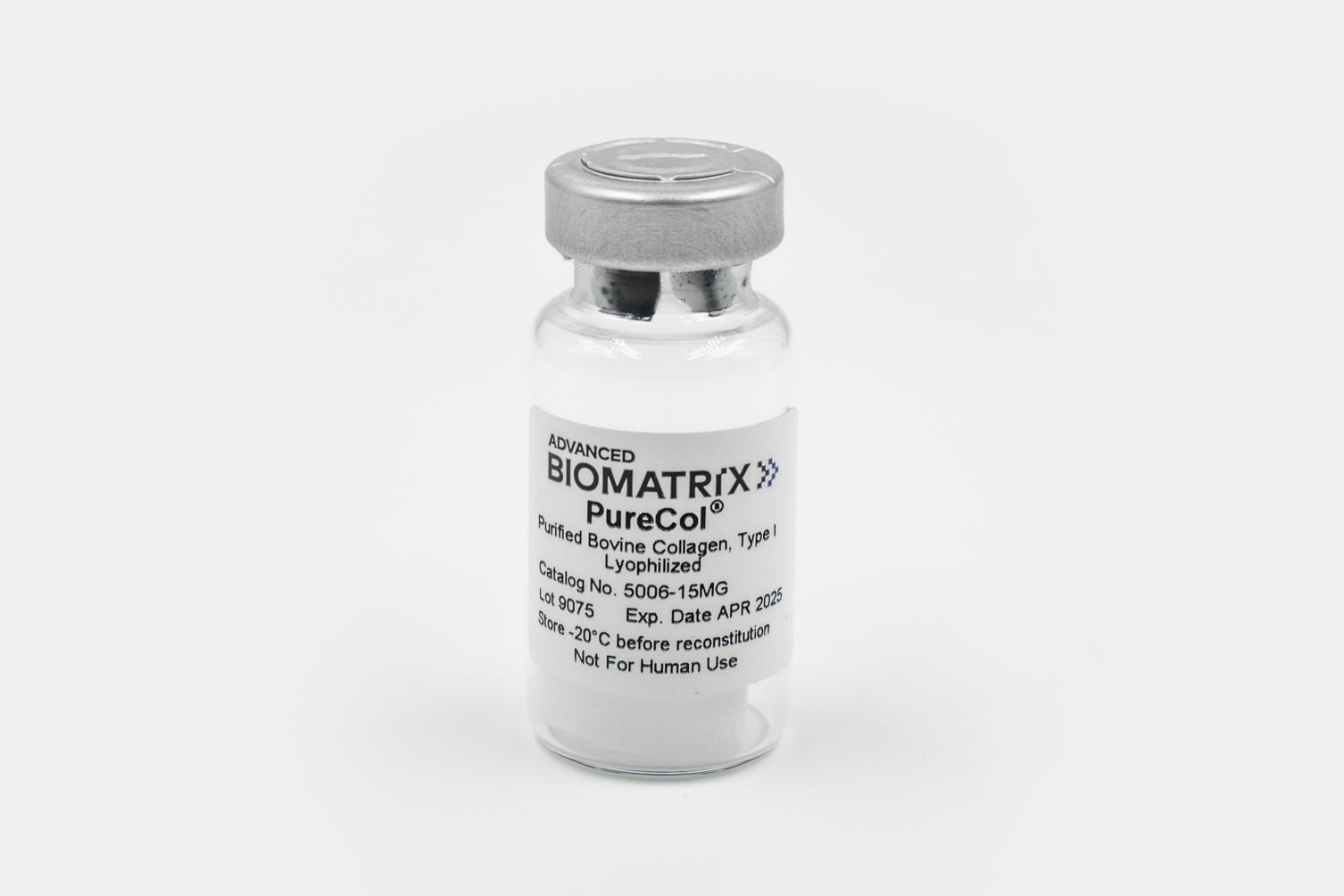-
Collagen
-
Type I - Atelocollagen
- PureCol® Solution, 3 mg/ml (bovine) #5005
- Nutragen® Solution, 6 mg/ml (bovine) #5010
- FibriCol® Solution, 10 mg/ml (bovine) #5133
- PureCol® EZ Gel, Solution, 5 mg/ml (bovine) #5074
- PureCol® Lyophilized, 15 mg (bovine) #5006
- VitroCol® Solution, 3 mg/ml (human) #5007
- VitroCol® Lyophilized, 15 mg (human) #5008
-
Type I - Telocollagen
- TeloCol®-3 Solution, 3 mg/ml (bovine) #5026
- TeloCol®-6 Solution, 6 mg/ml (bovine) #5225
- TeloCol®-10 Solution, 10 mg/ml (bovine) #5226
- RatCol™ for 2D and 3D, Solution, 4 mg/ml (rat) #5153
- RatCol™ High Concentration, Solution, 10 mg/ml (rat)
- RatCol™ lyophilized, 100 mg (rat)
- RatCol™ for Coatings, Solution, 4 mg/ml (rat) #5056
- Type I - Insoluble Collagen
- Type I - Bioinks
- Type II Collagen
- Type III Collagen
- Type IV Collagen
- Collagen Standard
-
PureCol® Collagen Coated Plates
- Collagen Coated T-25 Flasks #5029
- Collagen Coated 6-well Plates #5073
- Collagen Coated 12-well Plates #5439
- Collagen Coated 24-well Plates #5440
- Collagen Coated 48-well Plates #5181
- Collagen Coated 96-well Plates #5072
- Collagen Coated 384-well Plates #5380-5EA
- Collagen Coated 100 x 20 mm Dishes #5028
- MatTek Glass-Bottom Dishes
- MatTek Multi-Well Plates
- Collagen Scaffolds
- Collagen Hybridizing Peptides
-
Type I - Atelocollagen
- Tunable Stiffness
- CytoSoft™ Rigidity Plates
-
Bioprinting
- Support Slurry for FRESH Bioprinting
-
Bioinks for Extrusion Bioprinting
- Lifeink® 200 Collagen Bioink (35 mg/ml) #5278
- Lifeink® 220 Collagen Bioink (70 mg/ml) #5343
- Lifeink® 240 Acidic Collagen Bioink (35 mg/ml) #5267
- Lifeink® 260 Acidic Collagen Bioink (70 mg/ml) #5358
- GelMA Bioink
- GelMA A Bioink
- GelMA C Bioink
- Pluronic F-127 40% Sterile Solution
- GelMA 20% Sterile Solution
- Alginate 5% Sterile Solution
- Photoinitiators
- Bioinks for BIONOVA X
- Bioinks for Lumen X
- DLP Printing Consumables
-
Create Your Own Bioinks
- PhotoCol® Methacrylated Collagen
- PhotoGel® Methacrylated Gelatin 95% DS
- PhotoGel® Methacrylated Gelatin 50% DS
- PhotoHA®-Stiff Methacrylated Hyaluronic Acid
- PhotoHA®-Soft Methacrylated Hyaluronic Acid
- PhotoAlginate® Methacrylated Alginate
- PhotoDextran® Methacrylated Dextran
- PEGDA (Various Molecular Weights)
- Silk Fibroin, Solution
- PhotoSericin® Methacrylated Sericin
- Bioprinters
-
3D Hydrogels
- Thermoreversible Hydrogel
- Silk Fibroin
-
Type I Collagen for 3D Hydrogels
- PureCol® Solution, 3 mg/ml (bovine) #5005
- Nutragen® Solution, 6 mg/ml (bovine) #5010
- FibriCol® Solution, 10 mg/ml (bovine) #5133
- PureCol® EZ Gel, Solution, 5 mg/ml (bovine) #5074
- VitroCol® Solution, 3 mg/ml (human) #5007
- TeloCol®-3 Solution, 3 mg/ml (bovine) #5026
- TeloCol®-6 Solution, 6 mg/ml (bovine) #5225
- TeloCol®-10 Solution, 10 mg/ml (bovine) #5226
- RatCol® for 3D gels, Solution, 4 mg/ml (rat) #5153
- HyStem® Thiolated Hyaluronic Acid
- Methacrylated Collagen
- Methacrylated Gelatin
- Methacrylated Hyaluronic Acid
- Diacrylates
- Collagen Sponges
- Methacrylated Polysaccharides
- Spheroids and Organoids
- Extracellular Matrices
- HyStem / Hyaluronic Acid
-
Adhesion Peptides / Proteins
-
Recombinant Adhesion Proteins
- CD2, 0.5 mg/ml #5086
- CDH3, 0.5 mg/ml #5124
- CDH13, 0.5 mg/ml #5125
- CD14, 0.5 mg/ml #5089
- CDH18, 0.5 mg/ml #5090
- CD40, 0.5 mg/ml #5093
- CD86, 0.5 mg/ml #5096
- CD164, 0.5 mg/ml #5100
- CD270, 0.5 mg/ml #5127
- CD274, 0.5 mg/ml #5126
- CD276, 0.5 mg/ml #5123
- E-Cadherin (CD324), 0.5 mg/ml #5085
- ICAM2, 0.5 mg/ml #5107
- Adhesion Peptides
- Collagen Hybridizing Peptides
-
Recombinant Adhesion Proteins
- Reagents
- Assays
VitroCol® Lyophilized
Type I Collagen Powder, 15 mg (Human)
Catalog #5008
VitroCol® Lyophilized
Type I Collagen Powder, 15 mg (Human)
Catalog #5008
The VitroCol® lyophilized product comes with 15 mg of type I human atelocollagen used for 2D coatings or as a collagen standard. VitroCol® collagen is naturally secreted from human neo-natal fibroblast cells, then processed and purified to yield the naturally produced human collagen.
Product Description
VitroCol® collagen is the first widely available, naturally produced purified human collagen for research purposes. VitroCol® sets the standard for purity (>99% collagen content), functionality and represents the only native-like human collagen offered.
VitroCol® collagen is naturally secreted from human neo-natal fibroblast cells. The human fibroblasts are cultured in optimal conditions allowing the fibroblasts to naturally and efficiently secret extracellular matrix. The extracellular matrix is then processed and purified to yield the naturally produced human collagen.
VitroCol® is approximately 97% Type I human collagen with the remainder being comprised of Type III collagen. This product is supplied as a lyophilized powder with 15 mg of human collagen. When reconstituted with 5 ml of sterile 0.01 N HCl, a concentration of approximately 3 mg/ml is achieved.
VitroCol® is especially ideal for human cell culture systems when coating of surfaces and providing preparations of thin layers of culturing cells. VitroCol®, lyophilized form is not recommended for the formation of a solid gel. VitroCol® human collagen is provided in user-friendly packaging for use and storage. VitroCol® is supplied as a sterile, lyophilized powder.
| Parameter, Testing, and Method | VitroCol® Lyophilized Type I Collagen #5008 |
| Sterilization Method | Filtration |
| Extraction Method | Enzyme - atelocollagen |
| Form | Lyophilized Powder |
| Package Size | 15 mg |
| Storage Temperature | -20°C prior to reconstitution and 2-10°C after reconstitution |
| Shelf Life | Minimum of 6 months from date of receipt |
| Shelf life after reconstitution | 3 months |
|
Collagen Purity - Silver Staining |
>99.9% |
|
Electrophoretic Pattern - Coomassie Blue |
Characteristic |
| Sterility - USP modified | No growth |
| Endotoxin - LAL | <5.0 EU/mL |
| Cell Attachment Assay | Pass |
| Source | Human Neo-Natal Fibroblasts |
Directions for Use
Recommended Volumes for 2D Coatings or 3D Hydrogels
Download the full PDF version or continue reading below:
Coating Procedure
- Add 5 ml of sterile 0.01 N HCl solution to the VitroCol® serum vial containing 15 mg.
- Gently mix contents until material is completely solubilized. It may be necessary to agitate at 2 to 10°C overnight.
- Transfer desired volume of solution from the serum vial to a dilution vessel if required. Further dilute to desired concentration using sterile 0.01 N HCl solution. A typical working concentration may range from 50 to 100 ug/ml.
Note: Use these recommendations as guidelines to determine the optimal coating conditions for your culture system. - Add appropriate amount of diluted VitroCol® material to the culture surface.
- Incubate at room temperature, covered, for 1-2 hours. Aspirate any remaining material. Alternatively, incubate at room temperature until surface is dry.
- After incubation, aspirate any remaining material.
- Rinse coated surfaces carefully with sterile medium or PBS, avoid scratching surfaces.
- Coated surfaces are ready for use. They may also be stored at 2-10°C damp or air dried if sterility is maintained.
Product Q & A
Please review our collagen hydrogel whitepapers found here: https://advancedbiomatrix.com/3d-collagen-hydrogel-stiffness.html
Please visit our collagen gelation diagnosis page: https://advancedbiomatrix.com/collagen-gelation-diagnosis.html
Please view our white paper here:
https://advancedbiomatrix.com/recommended-volumes-for-coatings-and-hydrogels.html
We completed a study to show that DNA is completely destroyed at pH 2, and demonstrated that our collagen products do not contain DNA.
The collagen is fully hydrolyzed. The amino acid analysis is done using the Waters AccQ-Tag derivatization method. During the acid hydrolysis step, asparagine (N) is converted to aspartic acid (D) and glutamine (Q) is converted to glutamic acid (E). Tryptophan (W), if present, is destroyed during acid hydrolysis. Experimentally, one can determine the picomoles (pmol) of each amino acid per injected detected using amino acid standards.For the concentration determination, the total number of pmol of each amino acid is summed to get the total pmol of the 18 amino acids detected. The total pmol amino acids is divided by the theoretical number of amino acid residues in collagen based on the published sequence. The result is the pmol of collagen injected. The result is then multiplied by the dilution and 300,000 is used as the collagen molecular weight to get to mg/mL. The molecular weight of collagen is not well agreed upon.
Diluting with 1X PBS (rather than water or 0.01 N HCl) would have an effect for coating purposes. It would change the pH of the diluted collagen solution from acid to neutral pH. The pH change will transform the collagen molecules from a molecular form to a fibrillar form; and then the nature of coating surface will be changed from a monomeric coating to a fibrillar coating.
We use the following antibodies from SouthernBiotech:
1. 1310-02 – Goat Anti-Type I Collagen-FITC
2. 1310-08 – Goat Anti-Type I Collagen-BIOT
The major collagen molecular species in our Type I collagen products are monomers (approx. 70%), but there are dimers, trimers and a few percentages of oligomers too (approx. 30%) with some minor amounts of collagen fragments. The collagen monomer is a rod shaped molecule with 300 nm in length and 1.5 nm in diameter. The dimer, trimer and oligomer are 600 nm, 900nm and even longer in length respectively. According to the coating procedures, the collagen molecules are attached to the charged polystyrene surface randomly by charge or affinity in acid conditions during the 1-2 hrs incubation period at 37°C, and any unattached materials are removed by aspiration and rinsing. Therefore, the coated surface is a single layer of collagen monomer, dimer, trimer and oligomer mixtures. The thickness of the mono-molecular layer is dependent on how those molecules are attached on the surface. The coating density thickness would generally be characterized as a 1 molecule thickness which could be ranging from a few nanometers to a few hundred nanometers with the whole surface being covered by collagen.
The net charge of Type I collagen products’ (PureCol®, Bovine Collagen and VitroCol®, Human Collagen) molecule is directly related to the pH. At an acidic pH, the amino acids (zwitterions) along the collagen molecule are positively charged, making the entire collagen molecule positive. At the isoelectric point (or zone) of collagen, around pH 7-8, the amino acids along the collagen molecule are positively and negatively charged, making the net charge of the collagen molecule close to zero. At a basic pH, the amino acids along the collagen molecule were negatively charged, making the entire collagen molecule negative.
Further, the nature of the charge of the collagen coating surface will be dependent on the type of coating applied. For a monomeric collagen coatings when the collagen is applied under an acidic pH condition, the surface is positively charged. If the surface is rinsed with pH neutral buffer or media then it will change the charge of the collagen surface net charge close to zero. For a 3D gel coating, the collagen prepared under neutral pH; the net charge of the collagen surface is close to zero.
Using rotary shadowing technique under transmission electron microscopy, it was found that our collagen, on average, consists of approximately 80% monomers, 13% dimers, trimers, and oligomers with the remaining 7% collagen fragments.
Yes. The collagen molecule in PureCol, Nutragen, VitroCol, and all of our other Atelo collagen products were prepared from native collagen matrix by pepsin treatment under controlled conditions to remove the non-helical portion, telo-peptides, only and the helical portion is intact. In this case, the enzymatic active sites for MMP (Matrix Metalloproteinase), such as for Mammalian Collagenase Matrix Metalloproteinase 8 (MMP-8), on the molecule was preserved.
These pepsin treated collagen products should behave as native intact collagen.
TGF beta would have been digested with the pepsin enzymatic digestion step. It was undetectable by SDS PAGE silver stain as well. We didn’t do any specific measurements by ELISA however but presences of TGF beta is not anticipated.
We primarily use the Biuret method, but we also use BCA, AAA, and hydroxyl-proline assays.
- Collagen solutions that are frozen tend to have issues forming 3D hydrogels, and will likely not work. The solutions should still be good for 2D coatings.
- Collagen solutions that are left out at room temperature for extended periods of time may show signs of degradation, which will affect the formation of 3D hydrogels. It is likely still fine for 2D coatings.
Our recommendation is this: If you are using the product directly for a publication, we highly suggest buying a new bottle if the one you have was compromised.
In the publication "Fibroblast Promotes Head and Neck Squamous Cell Carcinoma Cells Invasion through Mechanical Barriers in 3D Collagen Microenvironments," they reported the porosity of FibriCol® type I atelocollagen hydrogels prepared at various concentrations, as reported below:
1 mg/ml = 5.7 + 2.3 μm
2 mg/ml = 3.7 + 1.5 μm
4 mg/ml = 1.3 + 0.7 μm
8 mg/ml = 0.8 + 0.4 μm
We can say that our coating saturates the available culture surface with a dense layer of collagen that is stable and cannot be washed off.
The “coating density” is represented by an array of molecules packaged at maximum, area-filling density, in a mono-molecular layer onto the surface.
The absolute mass of coated collagen per surface area depends on the Stoke’s radius and shape of the specific ECM being coated, yielding coating densities in the range of 0.2 – 0.4 micrograms of protein per square centimeter of available surface.
Our bovine collagen comes in two formats: Atelocollagen (enzyme extracted) and Telocollagen (acid extracted). The rat tail collagen we offer is Telocollagen.
When comparing both bovine and rat tail telocollagen products, some consider rat tail collagen to be more immunogenic compared to bovine.
For the triple helix section, rat tail collagen is 97.5% similar to human, while bovine is 99.3% similar.
From the publication https://doi.org/10.1016/j.matt.2025.102094, we see that telocollagen hydrogels polymerized at 37C form thinner fibers, with decreased porosity, and softer hydrogels.
Polymerizing telocollagen at 4C forms thicker fibers, increased porosity and firmer hydrogels. The stiffness values were evaluated by individual fibers, not bulk hydrogel stiffness.

Product References
References for VitroCol®:
Andrée, B. et al. Formation of three-dimensional tubular endothelial cell networks under defined serum-free cell culture conditions in human collagen hydrogels. Scientific Reports 9, (2019).
Shieh, Hester F., et al. "Comparisons of human amniotic mesenchymal stem cell viability in FDA-approved collagen-based scaffolds: Implications for engineered diaphragmatic replacement." Journal of pediatric surgery 52.6 (2017): 1010-1013.
van der Velden, Jos LJ, et al. "Transforming Growth Factor-ß Induces A Mesenchymal Profile In Human Nasal Epithelial Cells." D76. ALVEOLAR EPITHELIUM: NOVEL TOOLS AND PHENOTYPES. American Thoracic Society, 2012. A6322-A6322.
Tashima, Takumi, et al. "Osteomodulin regulates diameter and alters shape of collagen fibrils." Biochemical and biophysical research communications 463.3 (2015): 292-296.
Spiller, Kara L., Suzanne A. Maher, and Anthony M. Lowman. "Hydrogels for the repair of articular cartilage defects." Tissue engineering part B: reviews 17.4 (2011): 281-299.
Brilha, Sara, et al. "Monocyte adhesion, migration, and extracellular matrix breakdown are regulated by integrin αVβ3 in Mycobacterium tuberculosis infection." The Journal of Immunology 199.3 (2017): 982-991.
Jonsdottir, Hulda R., and Ronald Dijkman. "Characterization of human coronaviruses on well-differentiated human airway epithelial cell cultures." Coronaviruses. Humana Press, New York, NY, 2015. 73-87.
Sabbione, Florencia, et al. "Neutrophil extracellular traps stimulate proinflammatory responses in human airway epithelial cells." Journal of innate immunity 9.4 (2017): 387-402.
Dos Santos Brilha, S., et al. "Monocyte adhesion, migration and extracellular matrix breakdown is regulated by integrin αVβ3 in Mycobacterium tuberculosis infection."
Brilha, Sara, et al. "Monocyte Adhesion, Migration, and Extracellular Matrix Breakdown Is Regulated by Integrin aVb3 in Mycobacterium tuberculosis Infection." (2017).
Colace, T., et al. "Analysis of morphology of platelet aggregates formed on collagen under laminar blood flow." Annals of biomedical engineering 39.2 (2011): 922-929.
Muthard, Ryan W., and Scott L. Diamond. "Blood clots are rapidly assembled hemodynamic sensors: flow arrest triggers intraluminal thrombus contraction." Arteriosclerosis, thrombosis, and vascular biology 32.12 (2012): 2938-2945.
Maloney, S. F., Lawrence F. Brass, and S. L. Diamond. "P2Y12 or P2Y1inhibitors reduce platelet deposition in a microfluidic model of thrombosis while apyrase lacks efficacy under flow conditions." Integrative Biology 2.4 (2010): 183-192.
Bauer, Rebecca N., et al. "Interaction with epithelial cells modifies airway macrophage response to ozone." American journal of respiratory cell and molecular biology 52.3 (2015): 285-294.
Kawamura, Shunsuke, et al. "Identification of common monocyte progenitors, pre-monocytes, and granulocyte monocyte progenitors in human umbilical cord blood." Experimental Hematology 43.9 (2015): S72.
Product Certificate of Analysis
No result for .
Product Disclaimer
This product is for R&D use only and is not intended for human or other uses. Please consult the Material Safety Data Sheet for information regarding hazards and safe handling practices.







